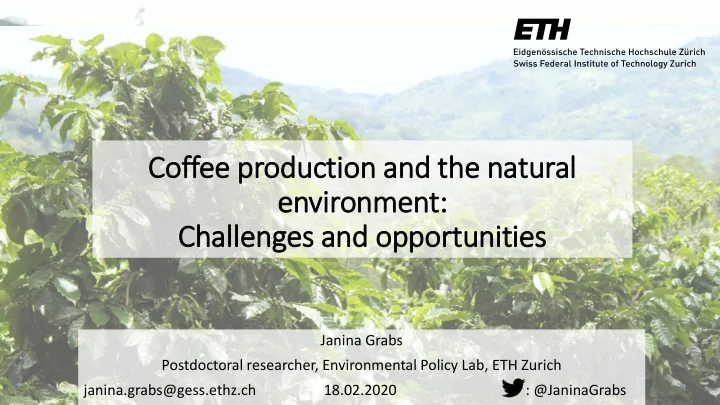

Coffee production and the natural environment: Challenges and opportunities Janina Grabs Postdoctoral researcher, Environmental Policy Lab, ETH Zurich janina.grabs@gess.ethz.ch 18.02.2020 : @JaninaGrabs
Climate change: A risk to coffee-producing regions • The two commercially grown coffee types, Arabica and Robusta, both have specific optimal biophysical growing conditions that determine their optimally suited production regions • Arabica varieties have an optimum temperature range between 15° and 24° C; rainfall between 1500 mm and 2000 mm per annum, and are typically cultivated at altitudes between 1000 and 2000 m (a.s.l.) • Robusta varieties grow best in areas with a mean annual temperature between 22° to 26° C, require abundant rainfall (~2,000 mm per annum), and grow best at altitudes between sea level to about 800 m (a.s.l.) (Killeen & Harper 2016)
Climate change: A risk to coffee-producing regions Greatest risks: Impacts on coffee production: • Higher temperatures (Arabica) • Lower productivity • Temperature variability (Robusta) • Higher disease incidence (coffee rust, coffee berry borer) → • Droughts Lower quality • Heavy rainfalls/storms • More frequent production • Changing/unpredictable rainfall shortfalls in key production patterns regions → price volatility
Not all regions are equally affected Robusta coffee suitability by 2050: blue/green = positive; orange = negative. Source: Bunn et al. 2015, Climatic Change
Not all regions are equally affected Arabica coffee suitability by 2050: blue/green = positive; orange = negative. Source: Bunn et al. 2015, Climatic Change
Climate change adaptation options • Changes of coffee production regions to more suitable areas • But: 60% of future suitable land is in forested areas (especially in Southeast Asia and the Andes) → deforestation risk (Killeen & Harper 2016) • Brazil and East Africa have expansion areas with lowest deforestation risk • Changes in income and livelihood sources for current coffee farmers • Diversification • Shifts to other cash crop or off-farm income • Adaptation of current areas • Use of more resistant cultivars (resistance to heat stress, water stress, disease) → will require replanting • Use of climate-smart agriculture practices
Climate-smart agricultural practices • Adapted varietals • Irrigation • Integrated Pest • Shade trees Management
A renaissance for shade coffee? The five categories of shade in which coffee is grown Source: Moguel and Toledo 1999, Conservation Biology, image: https://stanfordmag.org/contents/how-to-find-a-friendly-cup-of-coffee-nitty- gritty
A renaissance for shade coffee? • The Arabica coffee plant originated as a shrub in Ethiopian forests, making coffee an ideal crop to be planted in diverse agroforesty systems • Rustic systems and coffee gardens have higher biodiversity of plant, insect, bird, reptile, bat, and small mammal populations, and can act as biodiversity corridors connecting protected areas • Agroforestry can be an effective climate adaptation strategy as shade trees lower the mean temperature of the plot, protect crops against wind gusts and heavy rainfalls, and provide mulch and soil cover that can lower soil temperatures and increase water retention in soils • In addition, possibility of income diversification by selling tree crops (fruits, citrus) and selectively harvesting timber
A renaissance for shade coffee? • Yet, in recent decades the world has lost much of its shaded coffee agroforests (Jha et al. 2014) • Between 1970 and 1990, nearly 50% of shade coffee farms in Latin America were converted to low-shade (sun) systems • Between 1990 and 2010, this trend continued, but at a lower rate • Many newer coffee origins (e.g. Vietnam, Indonesia) tended to adopt sun coffee systems • Overall, in 2010 approximately 41% of global coffee area was managed with no shade, 35% with sparse shade, and only 24% with traditional diverse shade • Main reasons for this shift: Reaction to coffee rust outbreaks in the 1970s, continuing focus on increasing productivity on coffee areas
A renaissance for shade coffee? Global coffee production types and shade management in 2010 Source: Jha et al. 2014, BioScience, image: https://news.ucsc.edu/2014/05/images/shade_coffee_graphic.jpg
A renaissance for shade coffee? Challenges Benefits Global coffee production types and shade management in 2010 Source: Jha et al. 2014, BioScience
A renaissance for shade coffee? • Given the important climate change adaptation, biodiversity, and ecosystem service co-benefits of agroforestry, how could shade coffee production be rekindled? • How can we better compensate farmers for their lower yields when switching to higher-shade systems? • How can methods of differentiation and value addition be used for this purpose, given that the mainstream Voluntary Sustainability Standards do not require producers to pursue particular types of shade coffee/agroforestry management practices?
References and further reading • Bunn, C., Läderach, P., Rivera, O. O., & Kirschke, D. (2015). A bitter cup: climate change profile of global production of Arabica and Robusta coffee. Climatic Change , 129 (1 – 2), 89 – 101. https://doi.org/10.1007/s10584-014-1306-x • Grabs, J. (2020). Selling sustainability short? The private governance of labor and the environment in the coffee sector . Cambridge: Cambridge University Press. https://bit.ly/3bMMLgc • Jha, S., Bacon, C. M., Philpott, S. M., Ernesto Méndez, V., Läderach, P., & Rice, R. A. (2014). Shade coffee: Update on a disappearing refuge for biodiversity. BioScience , 64 (5), 416 – 428. https://doi.org/10.1093/biosci/biu038 • Killeen, T.J., & Harper, G. (2016). Coffee in the 21 st century: Will climate change and increased demand lead to new deforestation? Conservation International. https://bit.ly/2SFj1KP • Moguel, P., & Toledo, V. M. (1999). Biodiversity conservation in traditional coffee systems of Mexico. Conservation Biology , 13 (1), 11 – 21. https://doi.org/10.1046/j.1523-1739.1999.97153.x • Coffee & Climate initiative: https://coffeeandclimate.org/ • World Coffee Research: https://worldcoffeeresearch.org/
Please get in touch! • Get in touch! • For more info on my research: • https://janinagrabs.com/ • https://epl.ethz.ch/ • Email: janina.grabs@gess.ethz.ch • Twitter: @JaninaGrabs https://bit.ly/3bMMLgc
Recommend
More recommend